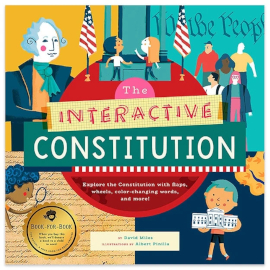The Interactive Constitution by David and Stephanie Miles works great as a standalone book for learning about our Constitution, the amendments, and how our government works. However, homeschooling parents who want to use it as part of their curriculum will be glad to know there is an Understanding the Constitution Notebook Companion™ created specifically for The Interactive Constitution that provides what’s missing to make it into a course for ages eight through thirteen.
The Interactive Constitution
The Interactive Constitution (TIC) is a hardcover book with double-thick, heavyweight pages that support openable flaps, two accordion booklets, a word decoder, a fold-out page, textured circles, a wheel, and other movable elements. All these elements help interest students in the information hidden inside and behind them. I was surprised at the amount of information in this 16-page book.
It’s about the U.S. Constitution, but it simplifies explanations in ways children can understand. For example, a color decoder reveals words in the Preamble to the Constitution. A movable triangle helps children understand the checks and balances between the three branches of government. The powers of Congress are illustrated in individual boxes, and a full-page wheel summarizes each of the 27 amendments to the Constitution.
TIC covers the basics quite well. For instance, it uses a two-page spread to provide details about each of the three branches of government. Among other topics covered are the Articles of Confederation, the Great Compromise (the makeup of the Senate and Congress), requirements for those who want to run for various offices, the Bill of Rights, and how to amend the Constitution. Occasional questions and keywords with their definitions are scattered throughout the book.
TIC also briefly addresses a few related events. While the Constitution created a particular form of government, the second page uses flaps to teach students about various forms of government: democracy, monarchy, aristocracy, and oligarchy—two sentences about each. One of the accordion booklets gives highlights of the Revolutionary War and the other addresses Famous Decisions of the Supreme Court. An entire page has flaps for presidents up through Donald J. Trump with a quotation under each of their images.
Understanding the Constitution Notebook Companion™
 Understanding the Constitution (UTC), a 72-page, black-and-white book by Carrie Fernandez and WriterBonnieRose, is available as a PDF or as a spiral-bound printed book from Daily Skill Building. This notebook has students write and draw based on the content of TIC.
Understanding the Constitution (UTC), a 72-page, black-and-white book by Carrie Fernandez and WriterBonnieRose, is available as a PDF or as a spiral-bound printed book from Daily Skill Building. This notebook has students write and draw based on the content of TIC.
Writing is mostly done in response to questions. Many comprehension-style questions can easily be answered by almost copying information from the book. (For the presidents, the notebook actually has students copy the quotation for each of them.) Some questions require students to summarize what they have read, such as those about the decisions of the Supreme Court covered in the booklet. Periodically, students are given a list of vocabulary words and terms to define in the glossary of the notebook. Some pages have boxes for students to draw, such as page 17 where they are to draw Independence Hall.
Eight pages offer Bonus Projects that list two research projects and two writing prompts. For example, one research project on page 19 asks, “Who helped negotiate the great compromise? What were some of the states on either side of the debate?” Generally, students will need to look beyond the content of TIC to answer these questions. Writing prompts on that same page direct students to answer some of the questions posed in TIC, but there are other prompts, such as one on page 30 that says: “If you could write a new law, what would it be? What would it allow or not allow?” All Bonus Projects are optional but should be especially useful for older students.
Toward the end of the book are eight formatted pages that can be used for do-it-yourself notebooking. They might be used for bonus projects or for other topics students want to investigate, write about, or illustrate.
Summary
I suggest using this course after spending some time on U.S. History so at least some of the characters and events are already familiar to students. Older students can work through both books on their own. Younger children will need more help, and parents might have them do more discussing and less writing.
Understanding the Constitution follows along with the pages of The Interactive Constitution, and no preplanning is needed. The two books can be used by the entire family, but if you have two or more children answering questions on their own, you might need another copy of The Interactive Constitution.








